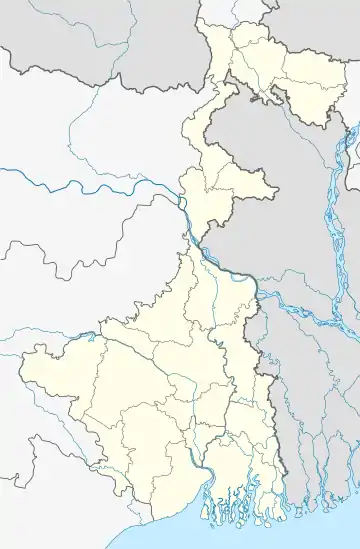Ghughumari
Ghughumari is a village and a gram panchayat in the Cooch Behar I CD block in the Cooch Behar Sadar subdivision of the Cooch Behar district in the state of West Bengal, India.
Ghughumari | |
|---|---|
Village | |
 Ghughumari Location in West Bengal, India  Ghughumari Ghughumari (India) | |
| Coordinates: 26.285752°N 89.470259°E | |
| Country | |
| State | West Bengal |
| District | Cooch Behar |
| Population (2011) | |
| • Total | 13,764 |
| Time zone | UTC+5:30 (IST) |
| PIN | 736170 |
| Telephone/STD code | 03582 |
| Vehicle registration | WB |
| Lok Sabha constituency | Cooch Behar |
| Vidhan Sabha constituency | Cooch Behar Dakshin |
| Website | coochbehar |
Geography
| Places in the Cooch Behar Sadar subdivision in Cooch Behar district CT: census town, M: municipal town, R: rural/ urban centre, H: historical/ religious centre Owing to space constraints in the small map, the actual locations in a larger map may vary slightly |
Location
Ghughumari is located at 26.285752°N 89.470259°E.
Area overview
The map alongside shows the north-central part of the district. It has the highest level of urbanisation in an overwhelming rural district. 22.08% of the population of the Cooch Behar Sadar subdivision lives in the urban areas and 77.92% lives in the rural areas.[1] The district forms the flat alluvial flood plains of mighty rivers.[2]
Note: The map alongside presents some of the notable locations in the subdivision. All places marked in the map are linked in the larger full screen map.
Civic administration
CD block HQ
The headquarters of the Cooch Behar I CD block are located at Ghughumari.[3]
Demographics
As per the 2011 Census of India, Ghughumari had a total population of 13,764. There were 7,019 (51%) males and 6,745 (49%) females. There were 1,704 persons in the age range of 0 to 6 years. The total number of literate people in Ghughumari was 9,146 (75.84% of the population over 6 years).[4]
Handicrafts
There are about 14,000 families weaving pati or sitalpati in and around Ghughumari. After the partition of Bengal in 1947, a number of families migrated from Tangail, now in Bangladesh, and settled in this area. They brought the age-old tradition of weaving pati and that helped them survive. Generally, men are engaged in growing the plants and extracting the fibre, and the women are engaged in weaving.[5]
References
- "District Statistical Handbook 2013 Cooch Behar". Tables 2.2, 2.4b. Department of Planning and Statistics, Government of West Bengal. Archived from the original on 21 January 2019. Retrieved 5 August 2020.
- "District Census Handbook, Koch Bihar, Series 20, Part XIIA" (PDF). Census of India 2011, pages 17-21 Physical feafures. Directorate of Census Operations, West Bengal. Retrieved 5 August 2020.
- "District Census Handbook, Koch Bihar, Series 20, Part XIIA" (PDF). Census of India 2011, Fifth page, map of Koch Bihar district. Directorate of Census Operations, West Bengal. Retrieved 22 July 2020.
- "C.D. Block Wise Primary Census Abstract Data(PCA)". West Bengal – District-wise CD Blocks. Registrar General and Census Commissioner, India. Retrieved 26 July 2020.
- "Sitalpati". Rural craft hub. Retrieved 16 August 2020.